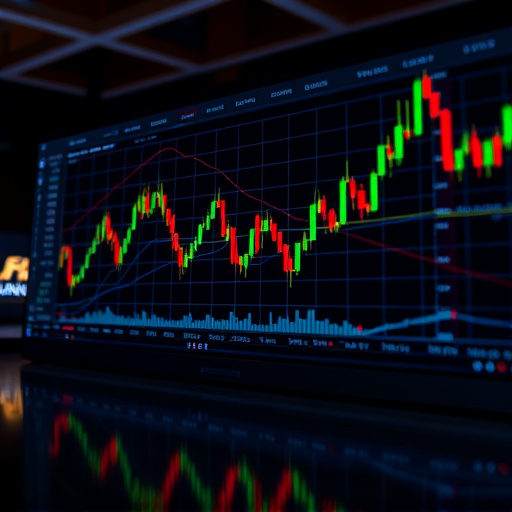Sydney's foreign exchange market is a bustling hub, central to global trade and investment flows, driven by economic and political forces. Australia's performance in mining and agriculture significantly impacts its currency (AUD), while global events and RBA interest rates influence fluctuations. Traders leverage GDP, inflation, and employment data for strategic precision, navigating political instability and stability that affect AUD value. Digitalization is revolutionizing the market, with tech-driven solutions improving efficiency and liquidity. Staying informed about economic indicators and geopolitical developments will be crucial for investors in this dynamic, evolving environment.
“Explore the dynamic landscape of Sydney’s foreign exchange market, where global currency trends meet local economic forces. This article offers an in-depth analysis, beginning with a comprehensive overview of the key players and dynamics. We delve into the primary drivers behind Australia’s foreign currency movements, including economic indicators that significantly impact trading strategies. Political landscapes also play a crucial role, shaping exchange rates unpredictably. Finally, we predict future trends and provide valuable insights for navigating Sydney’s FX market.”
- Understanding Sydney's Foreign Exchange Market: A Global Perspective
- Key Drivers of Foreign Currency Trends in Australia
- The Impact of Economic Indicators on Sydney's FX Trading
- Political Factors Influencing the Exchange Rates in Sydney
- Future Outlook: Predictions and Strategies for Sydney's Foreign Exchange Market
Understanding Sydney's Foreign Exchange Market: A Global Perspective

Sydney’s foreign exchange market is intricately woven into the global financial landscape, reflecting the interconnectedness of international trade and investment. As one of Australia’s primary financial hubs, Sydney plays a significant role in the Asia-Pacific region and globally, acting as a bridge between diverse currencies. This dynamic market is driven by various factors, including economic policies, geopolitical events, and international trade flows.
The city’s location and status as a major financial center attract traders and investors worldwide, creating a melting pot of currency trends. Understanding this market requires a global perspective, as movements in key international currencies can have profound effects on the Australian dollar and vice versa. With constant fluctuations, Sydney’s foreign exchange market offers both opportunities and challenges for participants, underlining its importance in today’s globalized economic environment.
Key Drivers of Foreign Currency Trends in Australia

Several key drivers shape the foreign currency trends within Australia’s vibrant foreign exchange market. One of the primary influences is the performance and stability of the Australian economy, which is closely tied to its significant exports, particularly in mining and agriculture. Global economic conditions also play a pivotal role; for instance, changes in interest rates set by the Reserve Bank of Australia (RBA) can impact the value of the Australian Dollar (AUD).
Geopolitical events worldwide and regional trade relationships further contribute to currency fluctuations. The AUD’s value, for example, often strengthens during periods of economic growth and stability but can be susceptible to market volatility stemming from political tensions or global financial crises. These factors collectively create a dynamic landscape within Australia’s foreign exchange market, affecting both local businesses and international traders.
The Impact of Economic Indicators on Sydney's FX Trading

In Sydney’s dynamic foreign exchange market, economic indicators play a pivotal role in shaping currency trends. Key factors such as Gross Domestic Product (GDP) growth rates, inflation figures, and employment data are closely monitored by traders due to their significant influence on a country’s monetary value. Positive economic indicators often strengthen a currency, attracting investors seeking higher returns. Conversely, negative reports can lead to a depreciation of the local currency as market participants anticipate potential risks.
These indicators provide valuable insights into a nation’s economic health and stability, which is essential for FX trading decisions. Sydney traders leverage this information to predict currency movements, allowing them to execute trades with strategic precision. By staying abreast of economic releases and their market impact, participants in the foreign exchange market can navigate the volatile yet lucrative landscape of global currency exchange.
Political Factors Influencing the Exchange Rates in Sydney

Political factors play a significant role in shaping the foreign exchange market, including that of Sydney. Global political events and domestic policies can have a profound impact on currency values. For instance, political instability in a country often leads to a depreciation of its currency as investors seek safer alternatives. On the contrary, stable political environments foster investor confidence, strengthening the local currency. In Australia, as in many countries, the actions of the government and central bank are closely watched by market participants. Decisions related to interest rates, fiscal policies, and trade agreements can influence the demand for Australian Dollar (AUD) in the foreign exchange market.
The Sydney exchange market, being a key global hub, is particularly sensitive to geopolitical developments. Regional conflicts, international trade tensions, or shifts in economic policies can cause fluctuations in AUD value. For example, changes in US-China relations might impact Australia’s currency due to its strong economic ties with both nations. Therefore, political factors are integral to understanding the dynamics of Sydney’s foreign exchange market and predicting future trends.
Future Outlook: Predictions and Strategies for Sydney's Foreign Exchange Market

The future of Sydney’s foreign exchange market looks promising, with several trends and predictions pointing to continued growth and evolution. One key factor is the increasing digitalisation of financial services, which allows for more efficient trading and wider access to global markets. As tech-driven solutions continue to enhance the market infrastructure, participants can expect improved liquidity, tighter spreads, and faster execution times.
Additionally, global economic factors will play a significant role in shaping Sydney’s forex market. Emerging markets’ growth, changes in interest rates, and geopolitical developments are all potential drivers of currency movements. Strategic investors might look to capitalise on these trends by adopting dynamic trading strategies that adapt to the ever-changing landscape. Diversification, risk management, and staying informed about economic indicators will be crucial for success in this dynamic environment.
Sydney’s foreign exchange market, heavily influenced by global currency trends, is a dynamic ecosystem driven by economic indicators, political factors, and international events. Understanding these key drivers is essential for both traders and investors navigating this complex landscape. As the market continues to evolve, staying informed about economic forecasts, geopolitical developments, and their impact on exchange rates will be crucial for successful participation in Sydney’s FX trading. Adopting adaptable strategies that incorporate real-time data analysis can help participants capitalise on opportunities and mitigate risks in this ever-changing environment.
